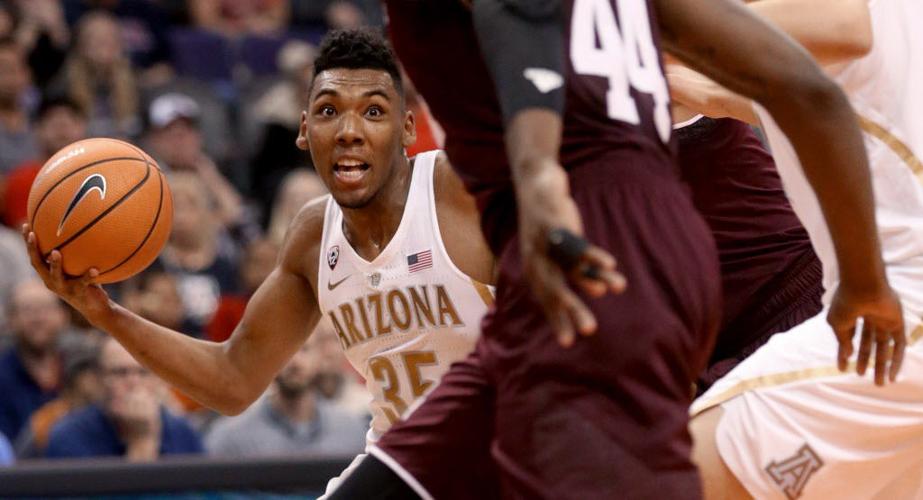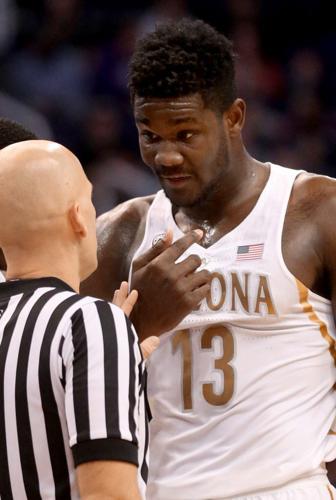College basketball’s RPI appraisal didn’t change much after Arizona beat No. 7 Texas A&M on Tuesday. The Wildcats, No. 54, continue to be ranked below Wagner, Lipscomb and Utah Valley State.
And South Dakota State, too.
That’s December basketball. Nothing sticks.
A year ago today, Arizona was 7-2 and was reeling from neutral-court losses to Butler and Gonzaga. The Wildcats started three freshmen in the Zags game — Lauri Markkanen, Rawle Alkins and Kobi Simmons — and the two most-used bench players were Keanu Pinder, with 20 minutes, and Chance Comanche, with 18.
Sky?
Falling.
And then Arizona won 15 consecutive games.
The in-season composition of most college basketball teams changes, sometimes subtly, sometimes swiftly. By the time Arizona reached last year’s Sweet 16, Comanche, Pinder and Simmons combined for just 17 minutes. In that Gonzaga loss, they played 67.
This UA team, a work in progress, is almost like a spring training baseball club playing its final week of the Cactus League at Salt River Fields.
Will Emmanuel Akot rediscover his game or be relegated to the bullpen as a middle-relief specialist?
Is Brandon Randolph going to win an everyday job at the top of the order?
Is the return of Rawle Alkins just a tease? Is there more to this than just a broken foot?
Saturday’s late McKale Center game against Alabama is almost like Opening Day at McKale Center. The Crimson Tide will be the first home opponent of substance — a parting gift from ex-athletic director Greg Byrne, now at ’Bama — and it will be time to reset the compass for Arizona basketball, 2017-18.
It’ll be a good time to return to reality. There’s nothing wrong with a 6-3 December record in college basketball, and it’s not that far from a typical Arizona start.
Sean Miller started 9-0 in 2013, 2014 and 2015, which warped expectations and made many of us forget that November and December isn’t meant to be a Cupcake Campaign.
Incredibly, prior to the 2012-13 season, Arizona had not started 9-0 since the magical run to No. 1 in Lute Olson’s first Final Four campaign, 1987-88.
That’s because Olson played a much more demanding nonconference schedule than Miller. Coming off the 1997 national championship, with all starters returning, Arizona opened a rocky 7-3.
But those losses were to Duke, Kansas and at Florida State.
More troubling, Olson’s 2001 Final Four team opened 7-4. The most talented team Olson ever coached lost early games to Purdue, UConn, Illinois and Mississippi State. But the ’01 Wildcats were rocked by the long illness and New Year’s Day death of Bobbi Olson.
Finally, in mid-January, Arizona won 20 of 22 games and reached its abundant potential.
This Arizona team, shaken by myriad suspensions on its roster and coaching staff and by an FBI investigation, will be fortunate to do the same.
Through nine games we’ve learned a few things that weren’t clear in the Red-Blue game:
- Superbly talented freshman center Deandre Ayton is neither a rim protector nor someone who will lead the league in dunks or blocked shots. He’s a non-traditional scorer for a 7-footer, who, typical of a freshman, is learning about defense and the need to play each possession aggressively. Ayton is the most important player in the Pac-12 and Arizona is desperate for him to force his will on opponents more than, say, Lauri Markkanen did a year ago. If Ayton doesn’t have another gear, Arizona probably isn’t a Final Four team.
- After being invisible the first five games, Brandon Randolph has scored 48 points and averaged 21 minutes. What’s the old Spike Lee movie — “He Got Game”? Now that he appears healthy and gaining confidence each game, Randolph could be as good as or better than last year’s first 20 games from Kobi Simmons, who averaged 11 points before Allonzo Trier’s midseason return.
- Although Trier didn’t play well against Purdue or Texas A&M, held to 5 for 17 shooting, he hasn’t kidnapped the offense. He is averaging 13 shots this season, two more than his sophomore season. Positive news: A career 46 percent shooter, Trier is up to 56 percent this year.
Texas A&M is ranked No. 4 in the current RPI numbers, and that’s probably a bit too high. Over a long season, I think USC will be a tougher out than the Aggies, even though A&M smashed the Trojans by 16 last month.
USC, like Arizona, has disappeared from the top-25 polls, and is No. 59 in RPI. That’s one slot ahead of Missouri State, which has lost to Georgia Southern and North Dakota State.
Today, those are meaningless numbers.
I’m sticking with my October prediction: Arizona will win the Pac-12 at 16-2 and USC will be biting at Arizona’s heels when the Pac-12 tournament begins in three months.
Unless, of course, Alkins remains sitting behind Arizona’s bench.





